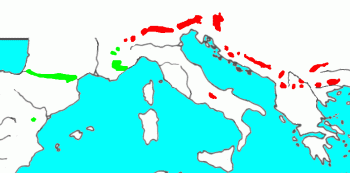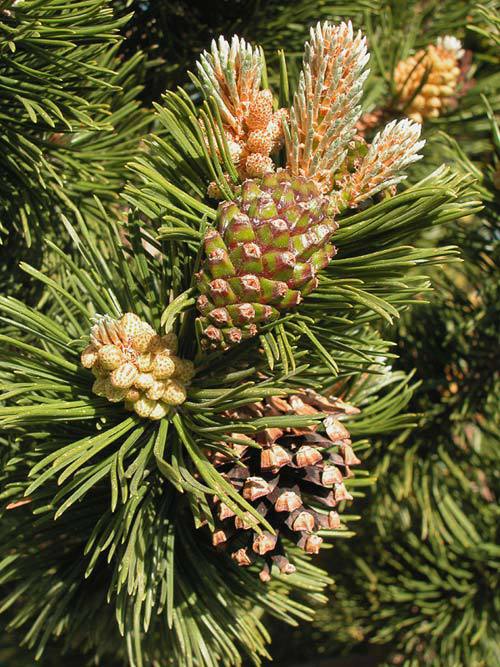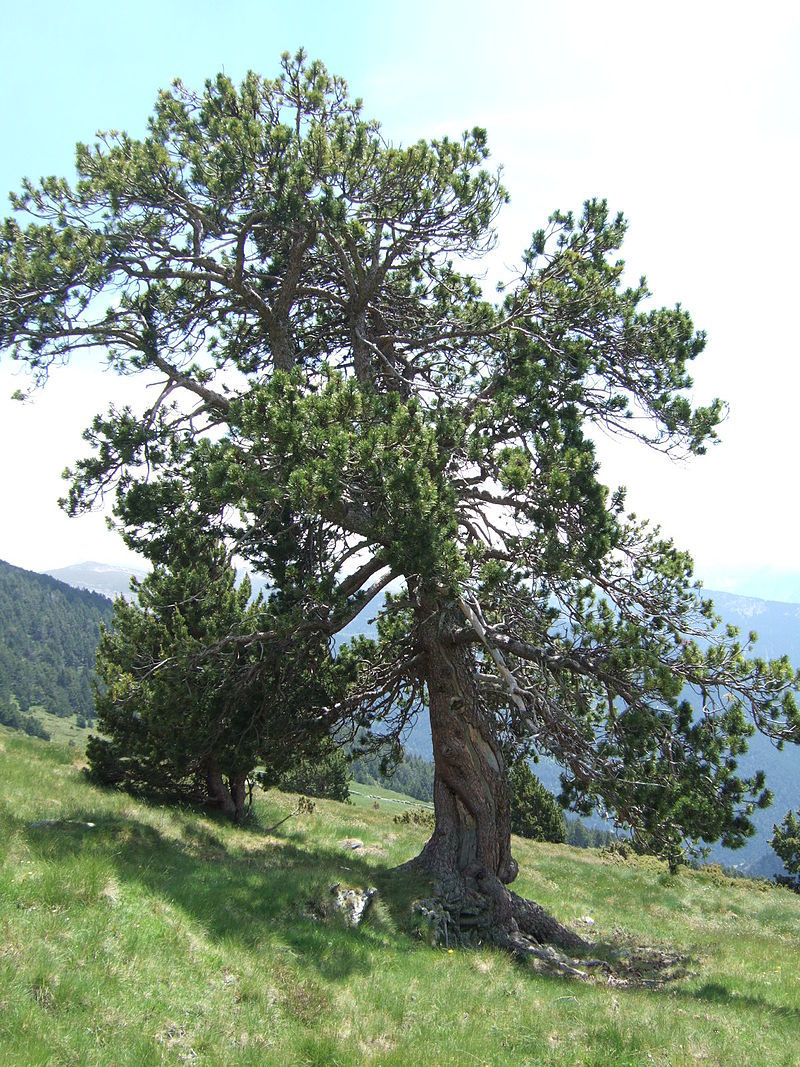subgenus Pinus, section, Pinus, subsection Pinus. This is one of the 'œclassic' old-world, 2-needled, hard pines.
Pinus uncinata, as described in 1805 by Louis-Florent-Marcel Raymond (1915-1972), ex Alphonse Louis Pierre Pyramus de Candolle (1806 - 1893), in Flore Française. Troisième Édition, by Jean Baptiste Antoine Pierre de Monnet de Lamarck, and Alphonse Louis Pierre Pyramus de Candolle, is commonly known as Swiss mountain pine, or mountain pine; as well as pin à crochets in the French language; and pino negro in Spanish. The species name, uncinata ("hooked point") refers to the pronounced prickle present on the seed cones.
Many authors consider this pine to be a subspecies of Pinus mugo, i.e. P. mugo subsp. uncinata.
Description. Swiss mountain pine is an evergreen, coniferous species of tree that grows to mature heights of 40 to 65 feet (12 - 20 m), with a straight, erect trunk 20 to 40 inches (0.5 - 1 m) in diameter, measured at breast height; and an ovoid-conic crown. Plants usually monoecious, rarely subdioecious.
- Bark is ash-gray-brown to blackish-gray colored, splitting into angular scaly plates, and is quite thick at base of trunk.
- Shoots are uninodal, with glabrous texture, colored grayish-black to deep red-brown and grooved between the decurrent scale-leaves.
- Foliar buds are ovoid-conically shaped, colored red-brown, and very resinous, measuring 0.24 to 0.36 inch (6 - 9 mm) long.
- Leaves (needles) are borne in fascicles of two (rarely three around apical buds on strong shoots). Individual needles are bright to dark green, often with a grayish tinge, growing straight to with a slight twist, and are minutely serrulate. Needles measure 0.92 to 3 inches (23 - 75 mm) long by 0.36 to 0.084 (inch (0.9 - 2.1 mm) thick, with a gray, persistent foliar sheath 0.6 to 0.72 inch (15 - 18 mm); persisting 4 to 9 years on the tree.
- Pollen cones measure 0.4 inch (10 mm) long, colored yellow or red. Pollen is released from May to July.
- Seed cones are colored purple ripening shiny dark brown in late September to October 15-17 months after pollination; opening at that point or the following spring. They are sessile on the shoot or nearly so, strongly asymmetrical, measuring 1 to 2.4 inches (25 - 60 mm) long, and 0.4 to 0.8 inch (20 - 40 mm) wide when closed, opening to 1.2 to 2 inches (30 - 50 mm) wide, deflexed down stem with angle of inclination to the stem 110°-160°. Cones shed soon after seed release or up to a year or two later.
- Cone scale apophyses are thick, strongly pyramidal on outer side of cone, still thickened and pyramidal on inner side but not strongly so. They are stiff and inflexible, measuring 0.24 to 0.4 inch (6 - 10 mm) long. Outer scale apophyses 0.16 to 0.36 inch (4 - 9 mm) thick, inner apophyses are 0.12 to 0.16 inch (3 - 4 mm) thick; umbo appears at the apex of apophyses, measuring 0.12 to 0.16 inch (3 - 4 mm) wide, often with a pronounced 0.04 inch (1 mm) prickle.
- Seeds are black in color, with a 0.12 to 0.16 inch (3 - 4 mm) body and a 0.28 to 0.48 inch (7 - 12 mm) wing, colored buff with darker streaks.
Distribution. This species is native to Europe - Sierra de Gúdar, Sierra Cebollera, Pyrenees, Massif Central, and the western Alps, overlapping widely with P. mugo subsp. mugo in eastern Switzerland and western Austria, with outliers as far northeast as the Böhmerwald and the Erzgebirge of eastern Germany, but absent from southeastern Europe. It is a high-altitude species, occurring mostly at elevations of 3,200 to 7,500 feet (1,000 - 2,300 m) above sea level, occasionally as low as 650 feet (200 m) in frost hollows and peat bog habitats in the northeast of its range in eastern Germany.
Hardy to USDA Zone 5 - cold hardiness limit between -20° and -10°F (-28.8°C and -23.3°C).








